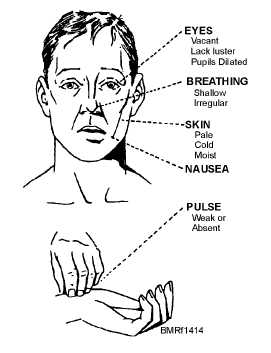Q6. What is a constricting band?
Q7. When a battle dressing is applied, what person
should release or remove it?
Q8. What is a battle dressing?
Q9. How should you apply a battle dressing?
SHOCK
Learning Objective: When you finish this chapter, you
will be able to—
Recognize the symptoms, prevention, and
treatment of shock.
If you’ve ever hit your finger with a hammer and
felt—in addition to the pain—weak, dizzy, and
nauseous, then you have experienced a mild form of
s h o c k . I n t h i s c a s e , t h e s y m p t o m s a p p e a r e d
immediately after the injury, but they may not show up
for several hours.
Shock is a condition in which blood circulation is
seriously disturbed. Crushed or fractured bones, burns,
prolonged bleeding, and asphyxia all cause shock.
Shock may be slight or it may be severe enough to cause
death. Because all traumatic injuries result in some form
of shock, you should learn its symptoms and know how
to treat the victim.
HOW TO RECOGNIZE SHOCK
A person who is going into shock may show quite a
few signs or symptoms, some of which are indicated in
figure 14-14, and are discussed in the following
paragraphs. Remember, that signs of shock don’t
always appear at the time of the injury; and, in many
very serious cases, symptoms may not appear until
hours later.
The symptoms of a person suffering from shock are
caused, directly or indirectly, by the disturbance of the
circulation of the blood. Symptoms of shock include the
following:
The pulse is weak and rapid.
Breathing is likely to be shallow, rapid, and
irregular, because the poor circulation of the blood
affects the breathing center in the brain.
The temperature near the surface of the body is
lowered because of the poor blood flow; so the face,
arms, and legs feel cold to the touch.
Sweating is likely to be very noticeable.
A person in shock is usually very pale, but, in
some cases, the skin may have a bluish or reddish color.
In the case of victims with dark skin, you may have to
rely primarily on the color of the mucous membranes on
the inside of the mouth or under the eyelid or under the
nail bed. A person in or going into shock has a bluish
color to these membranes instead of a healthy pink.
14-14
Student Notes:
Figure 14-14.—Symptoms of shock.


